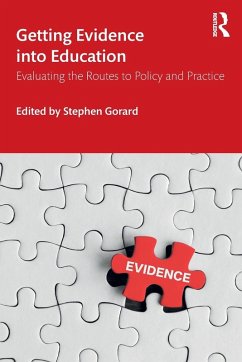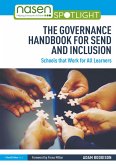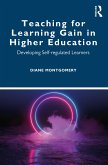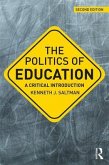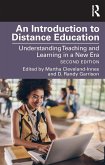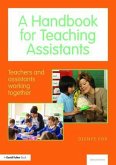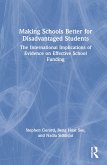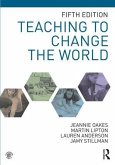Getting Evidence into Education
Evaluating the Routes to Policy and Practice
Herausgeber: Gorard, Stephen
Getting Evidence into Education
Evaluating the Routes to Policy and Practice
Herausgeber: Gorard, Stephen
- Broschiertes Buch
- Merkliste
- Auf die Merkliste
- Bewerten Bewerten
- Teilen
- Produkt teilen
- Produkterinnerung
- Produkterinnerung
Containing a variety of case studies, from evidence-based policies for early childhood education in Brazil, to the use of evidence on contextualized admissions to Scottish universities, the volume explores a variety of different ways to approach the problem of getting evidence into Education.
Andere Kunden interessierten sich auch für
![The Governance Handbook for SEND and Inclusion The Governance Handbook for SEND and Inclusion]() Adam Boddison (UK nasen)The Governance Handbook for SEND and Inclusion33,99 €
Adam Boddison (UK nasen)The Governance Handbook for SEND and Inclusion33,99 €![Teaching for Learning Gain in Higher Education Teaching for Learning Gain in Higher Education]() Diane Montgomery (UK Middlesex University)Teaching for Learning Gain in Higher Education49,99 €
Diane Montgomery (UK Middlesex University)Teaching for Learning Gain in Higher Education49,99 €![The Politics of Education The Politics of Education]() Kenneth J. Saltman (Professor of Educational Policy Studies at theThe Politics of Education49,99 €
Kenneth J. Saltman (Professor of Educational Policy Studies at theThe Politics of Education49,99 €![An Introduction to Distance Education An Introduction to Distance Education]() An Introduction to Distance Education69,99 €
An Introduction to Distance Education69,99 €![A Handbook for Teaching Assistants A Handbook for Teaching Assistants]() Glenys Fox (UK Education Consultant)A Handbook for Teaching Assistants49,99 €
Glenys Fox (UK Education Consultant)A Handbook for Teaching Assistants49,99 €![Making Schools Better for Disadvantaged Students Making Schools Better for Disadvantaged Students]() Stephen Gorard (UK Durham University)Making Schools Better for Disadvantaged Students149,99 €
Stephen Gorard (UK Durham University)Making Schools Better for Disadvantaged Students149,99 €![Teaching to Change the World Teaching to Change the World]() Jeannie Oakes (University of California, Los Angeles, USA)Teaching to Change the World109,99 €
Jeannie Oakes (University of California, Los Angeles, USA)Teaching to Change the World109,99 €-
-
-
Containing a variety of case studies, from evidence-based policies for early childhood education in Brazil, to the use of evidence on contextualized admissions to Scottish universities, the volume explores a variety of different ways to approach the problem of getting evidence into Education.
Produktdetails
- Produktdetails
- Verlag: Taylor & Francis Ltd
- Seitenzahl: 262
- Erscheinungstermin: 20. April 2020
- Englisch
- Abmessung: 234mm x 156mm x 14mm
- Gewicht: 402g
- ISBN-13: 9780367258832
- ISBN-10: 0367258838
- Artikelnr.: 59357886
- Herstellerkennzeichnung
- Libri GmbH
- Europaallee 1
- 36244 Bad Hersfeld
- gpsr@libri.de
- Verlag: Taylor & Francis Ltd
- Seitenzahl: 262
- Erscheinungstermin: 20. April 2020
- Englisch
- Abmessung: 234mm x 156mm x 14mm
- Gewicht: 402g
- ISBN-13: 9780367258832
- ISBN-10: 0367258838
- Artikelnr.: 59357886
- Herstellerkennzeichnung
- Libri GmbH
- Europaallee 1
- 36244 Bad Hersfeld
- gpsr@libri.de
Stephen Gorard is Professor of Education and Public Policy at Durham University, UK and a Fellow of the Academy of Social Sciences.
Section 1: Introduction to need for better evidence. Chapter 1: Why we
need better use of good evidence in education. Chapter 2: The importance
of providing evidence in education from rigorous evaluations. Chapter 3:
The global evidence and architecture in health and education: a comparative
scorecard. Chapter 4: What we know already about the best ways to get
evidence into use in education. Section 2: Experiences of different routes
to evidence use. Chapter 5: Hearts and minds: The Research Schools
Network: from evidence to engagement. Chapter 6: The development and
worldwide impact of the Teaching and Learning Toolkit. Chapter 7: Why is
it difficult to get evidence into use? Chapter 8: Generating research
evidence in teaching practice: Can teachers lead randomised control trials
in education? Section 3: Engagement with impact in different phases of
education. Chapter 9: First two years at school: Evidence-based policy for
early childhood education in Brazil. Chapter 10: Resarch into practice:
The case of classroom formative assessment. Chapter 11: Engagement and
impact in addressing and overcoming educational disadvantage. Chapter 12:
The use of evidence from research on contextualised admissions to widen
access to Scottish universities. Section 4: The role of leadership in
evidence uptake. Chapter 13: Is distributed leadership an effective
approach for mobilising research-informed innovation across professional
learning networks? Exploring a case from England. Chapter 14: The
opportunities and challenges of leaders using evidence in education.
Section 5: Suggestions for next steps in evidence use. Chapter 15: Towards
a better understanding of quality of evidence use. Chapter 16: Where next
for improving the use of good evidence.
need better use of good evidence in education. Chapter 2: The importance
of providing evidence in education from rigorous evaluations. Chapter 3:
The global evidence and architecture in health and education: a comparative
scorecard. Chapter 4: What we know already about the best ways to get
evidence into use in education. Section 2: Experiences of different routes
to evidence use. Chapter 5: Hearts and minds: The Research Schools
Network: from evidence to engagement. Chapter 6: The development and
worldwide impact of the Teaching and Learning Toolkit. Chapter 7: Why is
it difficult to get evidence into use? Chapter 8: Generating research
evidence in teaching practice: Can teachers lead randomised control trials
in education? Section 3: Engagement with impact in different phases of
education. Chapter 9: First two years at school: Evidence-based policy for
early childhood education in Brazil. Chapter 10: Resarch into practice:
The case of classroom formative assessment. Chapter 11: Engagement and
impact in addressing and overcoming educational disadvantage. Chapter 12:
The use of evidence from research on contextualised admissions to widen
access to Scottish universities. Section 4: The role of leadership in
evidence uptake. Chapter 13: Is distributed leadership an effective
approach for mobilising research-informed innovation across professional
learning networks? Exploring a case from England. Chapter 14: The
opportunities and challenges of leaders using evidence in education.
Section 5: Suggestions for next steps in evidence use. Chapter 15: Towards
a better understanding of quality of evidence use. Chapter 16: Where next
for improving the use of good evidence.
Section 1: Introduction to need for better evidence. Chapter 1: Why we
need better use of good evidence in education. Chapter 2: The importance
of providing evidence in education from rigorous evaluations. Chapter 3:
The global evidence and architecture in health and education: a comparative
scorecard. Chapter 4: What we know already about the best ways to get
evidence into use in education. Section 2: Experiences of different routes
to evidence use. Chapter 5: Hearts and minds: The Research Schools
Network: from evidence to engagement. Chapter 6: The development and
worldwide impact of the Teaching and Learning Toolkit. Chapter 7: Why is
it difficult to get evidence into use? Chapter 8: Generating research
evidence in teaching practice: Can teachers lead randomised control trials
in education? Section 3: Engagement with impact in different phases of
education. Chapter 9: First two years at school: Evidence-based policy for
early childhood education in Brazil. Chapter 10: Resarch into practice:
The case of classroom formative assessment. Chapter 11: Engagement and
impact in addressing and overcoming educational disadvantage. Chapter 12:
The use of evidence from research on contextualised admissions to widen
access to Scottish universities. Section 4: The role of leadership in
evidence uptake. Chapter 13: Is distributed leadership an effective
approach for mobilising research-informed innovation across professional
learning networks? Exploring a case from England. Chapter 14: The
opportunities and challenges of leaders using evidence in education.
Section 5: Suggestions for next steps in evidence use. Chapter 15: Towards
a better understanding of quality of evidence use. Chapter 16: Where next
for improving the use of good evidence.
need better use of good evidence in education. Chapter 2: The importance
of providing evidence in education from rigorous evaluations. Chapter 3:
The global evidence and architecture in health and education: a comparative
scorecard. Chapter 4: What we know already about the best ways to get
evidence into use in education. Section 2: Experiences of different routes
to evidence use. Chapter 5: Hearts and minds: The Research Schools
Network: from evidence to engagement. Chapter 6: The development and
worldwide impact of the Teaching and Learning Toolkit. Chapter 7: Why is
it difficult to get evidence into use? Chapter 8: Generating research
evidence in teaching practice: Can teachers lead randomised control trials
in education? Section 3: Engagement with impact in different phases of
education. Chapter 9: First two years at school: Evidence-based policy for
early childhood education in Brazil. Chapter 10: Resarch into practice:
The case of classroom formative assessment. Chapter 11: Engagement and
impact in addressing and overcoming educational disadvantage. Chapter 12:
The use of evidence from research on contextualised admissions to widen
access to Scottish universities. Section 4: The role of leadership in
evidence uptake. Chapter 13: Is distributed leadership an effective
approach for mobilising research-informed innovation across professional
learning networks? Exploring a case from England. Chapter 14: The
opportunities and challenges of leaders using evidence in education.
Section 5: Suggestions for next steps in evidence use. Chapter 15: Towards
a better understanding of quality of evidence use. Chapter 16: Where next
for improving the use of good evidence.

